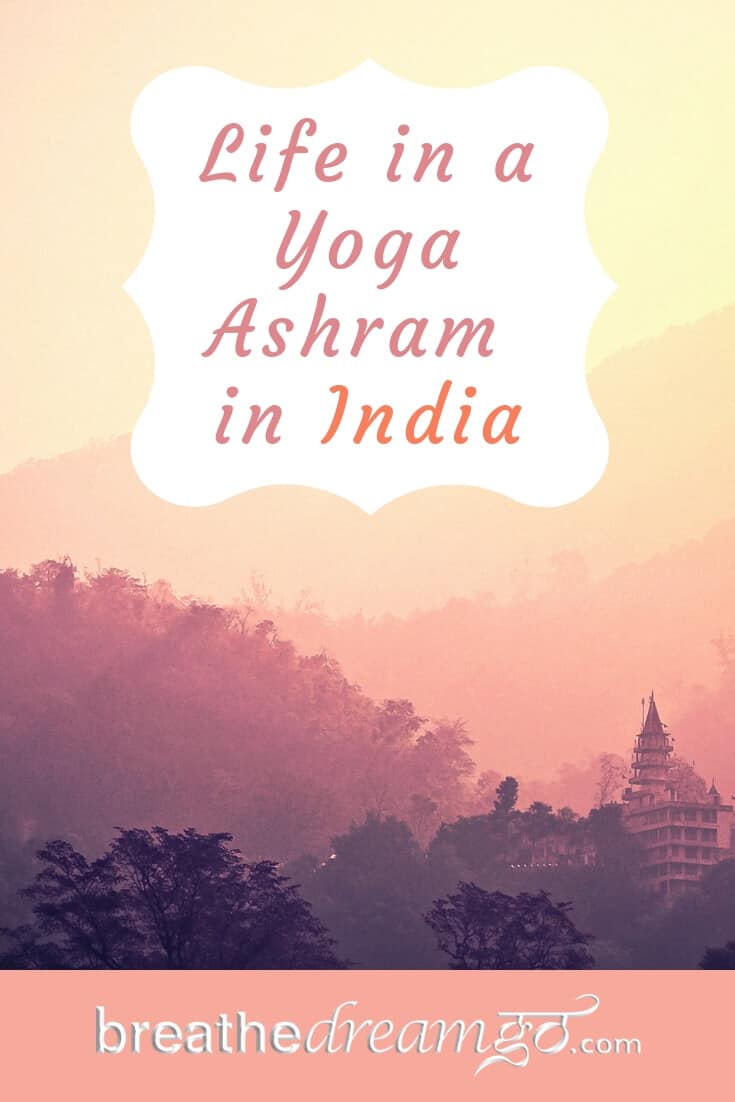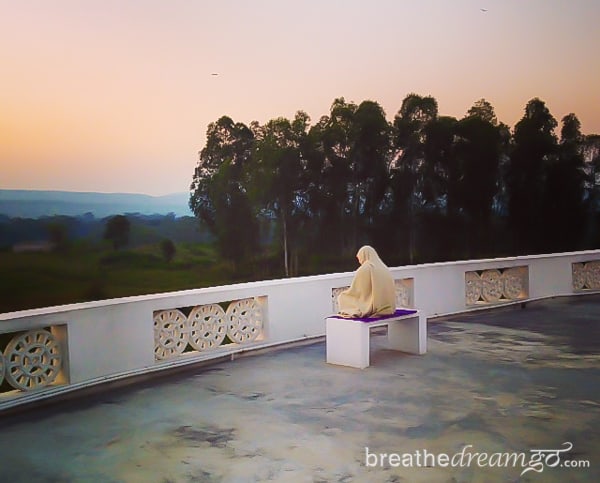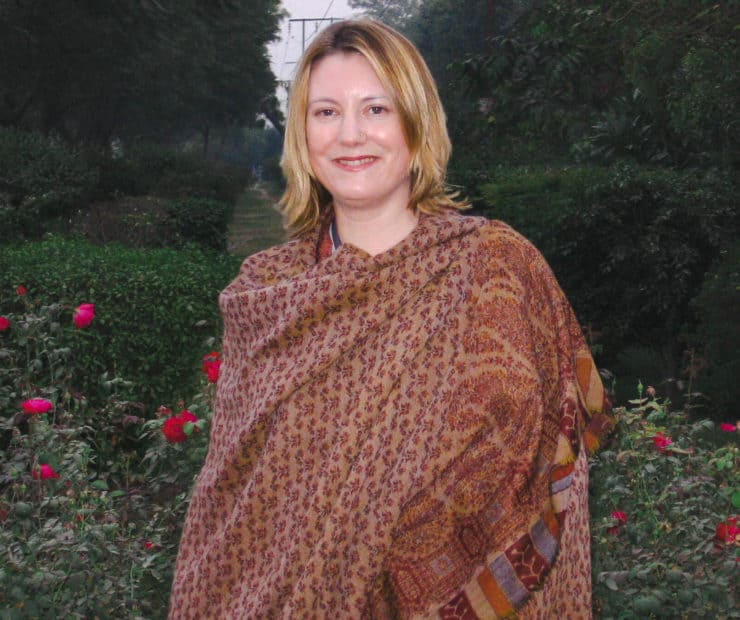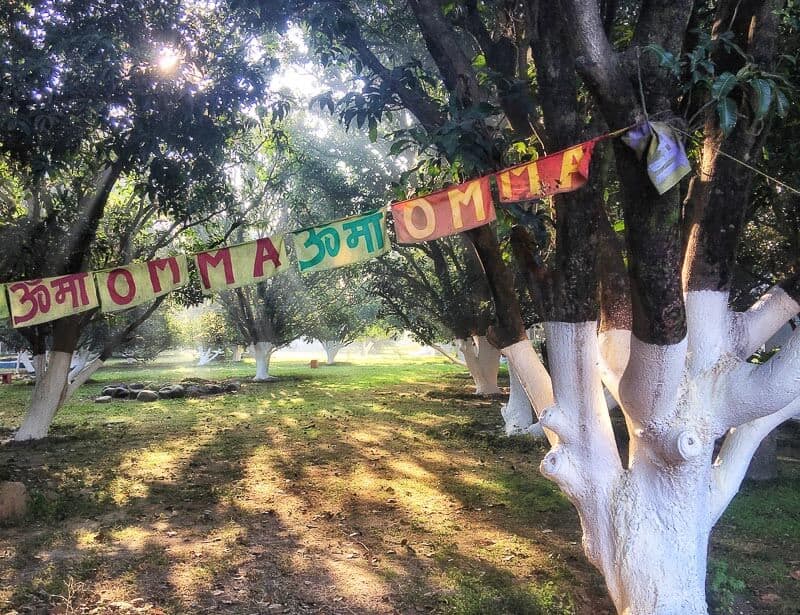
Table of Contents
Everything you need to know about visiting a Yoga Ashram in India
HAVE YOU CONSIDERED going to a Yoga Ashram in India? People have been congregating in Ashrams in India to practise Yoga and meditate since the dawn of time. But they’ve only become popular in the west since The Beatles went to the Maharishi Mahesh Yogi’s ashram in Rishikesh in 1968 and Yoga became a worldwide phenomenon.
Now, people from all walks of life are travelling to India to study and practise Yoga, and experience Ashram life. This post will help prepare you to visit an Ashram by answering all your questions about where to go, what to pack, what you need to know, and what to expect.
Interested in travelling to India for Yoga? Please read my Complete Guide to Yoga in India to have all of your questions answered.
- Why am I qualified to recommend Ashrams in India?
- What is an Ashram?
- How do you find an Ashram in India?
- What should you pack for an Ashram?
- What to expect at an Ashram?
- What is the daily routine?
- What is the food like at an Ashram?
- A day in the life of Aurovalley Ashram
Why am I qualified to recommend Ashrams in India?
For the past 25 years Yoga has been an important part of my life. I’ve practised Yoga since 1993, became a certified Yoga teacher in 2004, and started travelling to India in 2005. Over the past 13 years of travel in India, I’ve spent months in Yoga Ashrams. Though I have visited many, the two I have spent the most time in are Anand Prakash Yoga Ashram in Rishikesh, and Aurovalley Ashram in Rishidwar (between Rishikesh and Haridwar).
Anand Prakash was founded by Yogrishi Vishvketu (Vishvaji), an Indian Yoga teacher and his Canadian wife Chetana Panwar, from Toronto. Their Ashram is usually filled with western students, and their Yoga Teacher Training course in India is second to none. To read more about Yogrishi Vishvketu, Akhanda Yoga and Ananda Prakash, read Interview with a Master. I think Anand Prakash Yoga Ashram is the best Yoga ashram in Rishikesh, India.
Aurovalley Ashram was founded by Swami Brahmdev (Swamiji), who follows the teachings of Sri Aurobindo. This ashram attracts both Indian and foreign students – many of them from Colombia or Russia because Swamiji regularly travels to those countries. To read more about Aurovalley Ashram, read A Haven of Peace and Conscious Living.
Note: I would like to recognize the origins of Yoga as a school of Hinduism, an art and science that has been fostered from time immemorial in India. As someone who is not from this culture, I owe respect and gratitude to the Yoga teachers and traditions that I have learned and benefitted from. Pranam to all.
What is an Ashram?
Ashrams are places of spiritual retreat. They are not meant to be an escape from life, but a respite from worldly pursuits. They offer spiritual seekers a place where they can spend time concentrating solely on the spiritual aspect of life. What is the spiritual aspect of life? It is probably different things to different people, but to me, it’s a chance to be quiet, to spend some time on inner reflection and to think about the bigger questions of life – in other words, “what is my purpose in life,” rather than, “when is that hydro bill due?”
In this day and age of busyness and distraction, having time to be alone with yourself and listen to your inner voices, your heart, and the calling of your soul is probably the greatest of all luxuries. This is what Ashrams are for – to hear yourself think! I have personally found my time in Ashrams to be very healing. They helped me heal from the loss and trauma of losing my parents, and other inner wounds.
How do you find an ashram in India?
The best way to find an Ashram is to ask people you know, especially your Yoga teacher, or read my Complete Guide to Yoga in India for some recommendations. Some of the questions you should ask include: Does the Ashram or school take foreign students? Do they have a program for foreigners? Is instruction in English? Where, exactly, is the ashram or school? Is it accessible and in a place that has access to trains, the Internet, etc.
I know that people are searching for Yoga courses and Ashrams online, but I don’t recommend this method. Because of the popularity of Yoga, there are a lot of unscrupulous people opening schools, Ashrams, and retreat centres to take advantage of unsuspecting foreigners.
What to pack and how to get ready for your Ashram adventure
Once you’ve decided to stay at an Ashram in India, and you know where you’re going, it’s time to start getting ready. Find out everything you can about the Ashram – including the amenities, daily routine, accommodations, and what you need to bring. Talk to people who’ve been there to find out what it’s really like.
Ashrams are not hotels, they do not come equipped with mod cons and supplies. They tend to be very simple, and you have to bring almost everything you need with you – but remind yourself that you are not going to indulge in luxury.
Bring what you need, but bring the bare minimum, such as: all the toiletries you need, including soap, shampoo and medications, a flashlight, a towel, a shawl or sweater (it can be chilly at night in the mountains), loose cotton clothes, preferably Indian-style (tight-fitting and skimpy spandex Yoga pants and clothes are not appropriate), flipflops or sandals, sunscreen, mosquito repellent, a hat, long scarf and oil for dry skin, plus books, writing materials, and laptop. Even ashrams have WiFi these days!
December-February in Rishikesh is quite cold, so you will need warm clothing; but April to October is very hot.
What to expect at an Ashram?
Preparations can only take you so far when you’re travelling or experiencing something new — you have to expect the unexpected. And this is doubly, triply true of travel in India! It’s also especially true of doing something that is off-the-radar for most people from the west, where spirituality, and even just the concept of looking within, is nowadays considered a radical notion.
Looking within is exactly what you do at an Ashram, and if you’re new to it, you may not know where to start — or where to look. That’s what the daily routine is for. The daily routine grounds you in the life of the Ashram and provides you with a map. The “destination” is your unique experience and epiphanies. When in doubt, follow the routine and have faith that something will happen! And if that something turns out to be an emotional catharsis or breakthrough, the routine will support you as you go through it.
I always go through a few very uncomfortable days of unwinding when I first get to the ashram. I usually feel like I have the flu, but I know it’s the symptoms of a natural detoxification. Click here to read the full article What to expect at an ashram and the daily routine.
Accommodation depends on the ashram. In some ashrams, most people sleep in dorms and share washrooms; in others, you can have a private room or share with just one other person, and each room has its own bathroom. The rooms are very simply furnished, but they have everything you need (unless you need a TV and A/C). The simplicity helps to clear your mind. I particularly love the simple, white rooms at Aurovalley Ashram. They were beautifully designed for maximum flow of sunlight and fresh air, and I feel they are very elegant in their simplicity. Solar panels on the roof even provide hot water showers – a treat!
The rules are simple, too: no meat, alcohol, drugs, cigarettes, outside visitors in the rooms. Some also stipulate no sex, even with your spouse (though not usually at the Ashrams that cater to foreigners). Previous Yoga or meditation experience is usually not required. The most important thing is sincerity.
I know that ashram life is not for everyone, but it sure suits me. I find staying in the ashram to be very healthful and creative, and I make time for it every year. A few days can do wonders, but a few weeks – even months – can really make a lasting difference in your life.
What is the daily routine?
There is a set daily schedule, which many ashrams expect you to follow. It depends somewhat on whether the ashram caters to Indian or foreign students: the Indian ones tend to be stricter. This schedule, from Aurovalley Ashram, is typical:
- 6 am – collective, silent meditation
- 7 am – Yoga (asana) class
- 8 am – breakfast
- 9-11 – Karma Yoga (the opportunity to donate time or skills to the Ashram)
- 11:30 – Satsang (spiritual enquiry where you can ask the teacher questions)
- 1 pm – lunch
- Afternoon – free time
- 6 pm – meditation
- 7 pm – dinner
- 8 pm – collective reading in the library or kirtan
The day’s flow is dictated by the regular activities – a predictable mix of meditation, yoga, satsang, kirtan (chanting) and meal times. Plus, there is personal time for exercise, exploration, writing, healing (Ayurvedic therapies and massage are usually close at hand) – whatever you choose to pursue. The always-vegetarian food is served in a communal dining hall, and you have to clean your own tin thali (plate) afterward. The food is simple and wholesome, filling and satisfying (though perhaps not to a real foodie).
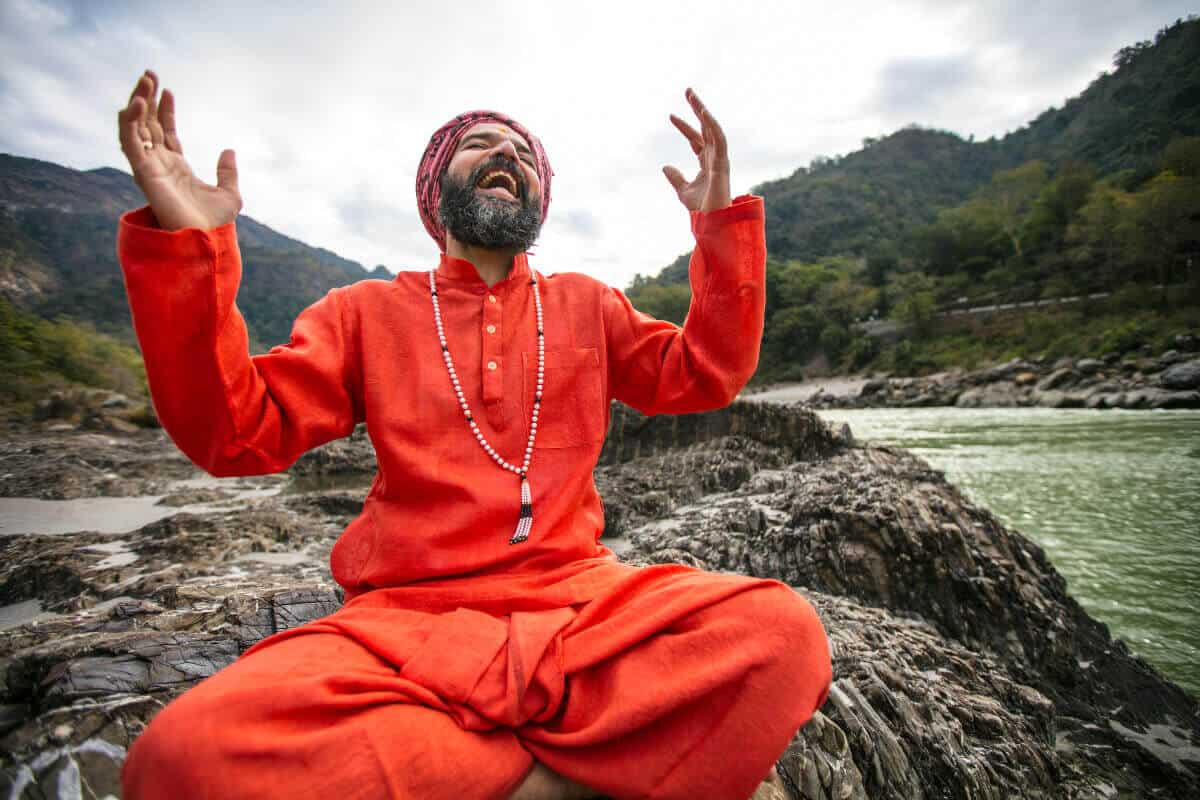
Ashram routine highlights
The highlight of the Anand Prakash schedule, for me, is the 6 am yoga class, taught by Vishvaji in the top-floor yoga hall. The hall has huge picture windows that frame the awe-inspiring site of the sun coming up from behind the Himalayan foothills. In late winter, an invigorating early morning wind rushes down from the mountains – and really does feel like a blast of Shiva energy (Shiva is the god of yoga, and one of the three primary gods in the Hindu pantheon).
At Aurovalley, I love the profound calm of the circular meditation hall, but the day’s highlight for me is satsang, which means, “search for truth.” Every day at 11:30 am, until 1 pm lunchtime, Swamiji in the Ashram library and answers questions. This is the time-honoured method of spiritual instruction in India.
What is the food like at an Ashram?
Breakfast is often some kind of wheat bread – roti, paratha or naan – and fruit or dal (lentils), plus tea. Lunch is usually rice and dal, plus salad or fruit or an Indian dessert such as burfi (a solid milk sweet); and dinner is a whole lot like lunch. The food is only very lightly spiced and does not include garlic or onion; and it is extremely well-washed and purified so that even the most delicate foreign tummy can handle it.
The quality / taste of food at Ashrams varies (but, hey, you’re not there for the food!). Anand Prakash has the BEST ashram food I’ve ever tasted, it is superb. At Aurovalley, I make sure I have an airtight plastic box full of treats that I pick up in Rishikesh.

A day in the life of an Indian Yoga Ashram
Morning
In the pre-dawn hours, Aurovalley Ashram is a receptacle of peace. The air is filled with devotion. Birds sing and sacred music floats in from another nearby ashram. In the east, towards the Ganga River and the misty mountains of mysterious Rajaji National Park, a pale yellow band starts to widen on the horizon.
After the ritual of getting washed and dressed, I throw a shawl over my shoulders and close the metal door of my room by 5:55 a.m. I soak up the serenity and natural beauty of this garden-like ashram in north India, between the sacred cities of Haridwar and Rishikesh, and walk in the half-dark along a path lined with the abundance of nature.
I take my seat in the circular meditation hall, beneath large, black-and-white portraits of Sri Aurobindo and The Mother, who look out with an unending well of love, compassion and understanding. In the centre of the room a large green crystal ball glows. The founder of Aurovalley Ashram, Swami Brahmdev (Swamiji), walks in and sits across the room from the portraits; other sadhaks (people who live, or who are staying, at the ashram) quietly take their places in the darkened room. Incense burns beneath the portraits in homage; and the only sounds are the many birds that inhabit this natural paradise.
Your responsibility is to know yourself. The definition of responsibility is to become aware of your abilities and respond to them. Become aware of your abilities and give your life to them. Swami Brahmdev
This is the magic sadhana hour, the hour when the world awakes and celebrates the miracle of the sun, of life and of beauty. Everything is washed clean, afresh, humming with sacred energy. After an hour of meditation, I walk out to a pink-tinged sky, the sun just appearing over the horizon, and walk the very short distance to the yoga hall. Lined with floor-to-ceiling plate glass windows, the yoga hall invites the morning sun.
Dhyana, the ashram manager, and long-time resident, takes her place at the front of the room. She opens the doors to let the fresh air in, and leads us gently through a one-hour class. Around the time the class ends, we hear the loud clang of the meal gong signalling breakfast.
It’s easy to live when you realize everything is temporary. When you call something “mine” you give birth to ego. Choosing ego will not make you beautiful. Swami Brahmdev
Breakfast of porridge and fruit, or chapati and beans, and hot milky tea is served by two sadhaks, and people can choose to eat inside or outside around a massive tree. Everyone washes their own metal plates, cups and cutlery, and so by 8:30, the activities of the day begin. A small yellow school bus leaves to pick up local children and their teachers, and bring them back to the school and playground on the ashram grounds, and people begin working to contribute karma yoga activities or take care of personal business. There is nothing on the ashram schedule until satsang at 11:30 a.m.
Afternoon
Sometimes, like the other sadhaks, I take the school bus into Raiwala village to buy fruit, peanuts, sweets and a cold Limca. Then I walk back, through the village and the countryside, passing meandering cows, groups of school children in crisp uniforms, men on bicycles and motorcycles, women at work around their houses and Indian soldiers who are here for education and retraining. It’s a pleasant walk, about four or five kilometres, and the setting becomes more and more pastoral as I reach the ashram.
Nature has given us the power to smile and laugh to deal with difficulties. Laugh at your life and it will become easy. Swami Brahmdev
At about 11:30 everyone gathers either under the mango tree or in the library for satsang, a Sanksrit word that means “in the company of the highest truth.” Swamiji sits before us and answers questions, in the time-honoured tradition of Indian spiritual enquiry. Questions range from, “what is consciousness?” to “how can I get rid of unwanted thoughts?” to “why do we meditate?” Swamiji answers every question with enthusiasm, generosity and conviction; his spiritual understanding springs from a deep well infused with the teachings of Sri Aurobindo and The Mother and his own realizations. His answers are fresh and original and he speaks English with style and wit. Swami Brahmdev has written several books and also writes regularly for the popular Times of India Speaking Tree website / column.
Satsang is the spiritual heart of the ashram, and it is something I try to never miss. I feel inspired by Swamiji’s words and the quiet, concentrated energy of the group. Lunch immediately follows, the biggest meal of the day, with rice, vegetables, dal (lentils) and sometimes salad fresh from the ashram garden. Like all the other meals, people eat mostly in silence; and even the children at the ashram speak very quietly. After lunch again is free time, for karma yoga or personal activity. Some people garden or clean; or help out with specific skills — on one visit, I proofread and edited one of Swamiji’s books, for example.
Live life full of faith and trust in yourself. Meet life with that faith and confidence. Swami Brahmdev
In the late afternoon, the bookstore opens, run by a long-time ashram resident from France. The bookstore sells many books by Sri Aurobindo and The Mother as well as some other spiritual writers; and incense, mala (prayer beads), and other products made by the Aurobindo industries in Pondicherry (Puducherry), the site of the main Aurobindo ashram (and where Sri Aurobindo lived for the latter part of his life).
And then the gong goes for tea time! One of my favourite times at the ashram. The shadows are becoming long, and the hot mid-day sun is dissipating. People break from their activities to get a cup of hot milky tea from the dining hall. For me this is prime writing time. Cleaning, laundry and other personal chores are done; I have tea; and the sun is not too hot (unless I am at the ashram in April or May). In fact, I am writing this on the terrace beside my room, under thick, luxurious foliage, drinking hot tea and feeling very happy, very content and very peaceful. This is about as good as it gets for me!
Thoughts are a power. You can choose your thoughts. With your thoughts, you make your life. Swami Brahmdev
Sometimes, at 4:30, there is another yoga class in the yoga hall, depending on who is here to teach it. Currently, there is a very good teacher here from Colombia who teaches a vigorous vinyasa-style class. So, each day at 4:15 I decide if I want to exercise my mental / creative self with more writing, or my physical self with more yoga. It’s the kind of dilemma I love to have.
But sometimes, like the other sadhaks, I go out from the ashram in the afternoon. Recently, I went to Haridwar for the aarti with a group of women from Colombia who had room in their tourist bus; and to Rishkesh for the aarti with two young women from Australia; we split the price of a taxi.
Evening
Dusk is called the magic hour, and nowhere is it more magical than Aurovalley. The sun sets across the fields and behind a mountain, and the streaks of light seem to bring an incredible clarity to the white buildings, green lawns and thick trees with freshly painted white trunks. Birds play in the trees, the parrots flashing bright green; and the afternoon sun has heated the fields of tulsi, releasing the intoxicating aroma. Local farmers and other workers gather their tools and begin to head home. I sometimes hear a herd of cows being driven along the country road beside the ashram.
This is a lovely time to walk through the fields and down a rocky path, past a sadhu’s ashram, to the banks of the holy Ganga, the Ganges River, Mother River of India. There is a small ghat beside the river, with a tiny Hanuman temple; and to sit here and watch the river flow past, and stare out at the mist-covered Shivalik hills of Rajaji National Park, is to experience a kind of natural high. For this is my favourite place on earth, the most peaceful, inspiring and sacred place I have ever been. There is something timeless and primordial about the scene. The pandit shows up wearing the saffron robes pandits have always worn, the river flows as it has always done, the wild mountains are filled with elephants, leopards, snakes, birds and other creatures, as it has always been.
Meditation is a process of coming back home. Anything that brings you more near to yourself is meditation. Swami Brahmdev
To walk meditatively here to the evening (6 p.m.) meditation is to arrive in the perfect state, filled with gladness and gratitude. I sit with one eye on the portraits and another on the open door facing the sunset. My whole being says thank you to the divine for creating such beauty and for giving me the opportunity and ability to experience it. After some meditation time, Swamiji begins to chant, deeply, resonantly; and I feel I am hearing the voice of the divine, rolling around the circular marble chamber. I look outside and see a perfect crescent moon, a glowing disc hanging in the azure sky above the darkened trees.
After Swamiji finishes chanting, people begin to drift out of the meditation hall and into the deepening twilight. The gong is sounded and it’s dinner time. The end of a long lovely day. Dinner is eaten in tranquility and afterwards people relax for a short time together, and then drift towards their rooms. By 8 p.m. the ashram is quiet. I love this time alone in my room to read and write … and log onto the internet or sometimes make phone calls. It is morning in Canada, and a good time to connect with people. But, in truth, I do not feel like socializing at this time. I prefer to go up on the roof and commune with the stars, which are very visible as the ashram is located in the countryside.
Silence is one of the symptoms of psychic awakening. Only in silence can you understand life and know what to do, what to say, what to eat, where to go. Swami Brahmdev
By the end of the day at Aurovalley Ashram, I feel like I have dropped deeply within myself, where I am in tune with my own inner rhythm. And that is really what being at Aurovalley is all about for me: reconnecting with myself, especially the part of me that is endless, timeless, divine.
PIN it on Pinterest
If you enjoyed this post, please sign up to The Travel Newsletter in the sidebar and follow Breathedreamgo on all social media platforms including Instagram, TripAdvisor, Facebook, Pinterest, and Twitter. Thank you!


